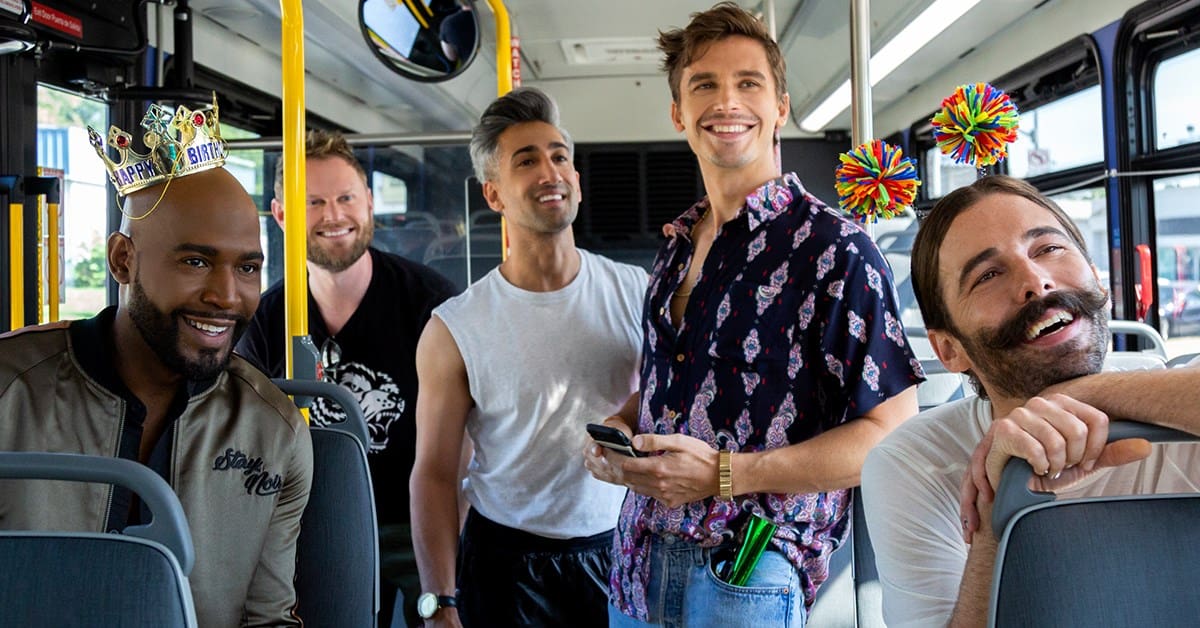
After watching the entirety of season 3 of Queer Eye in only two sittings, I struggle to remember a time before this show existed. How did we survive? How did we as a society understand the value of self-care and self-worth? Did we all just resort to retail therapy – or perhaps real therapy – for healing? I guess we’ll never know.
Only a year after Netflix revitalized the classic Bravo hit TV series Queer Eye For The Straight Guy for a younger, more progressive audience, the show’s third season has already brought joy, tears, and healing to the streaming nation. Tan, Jonathan, Karamo, Bobby, and Antoni are back to makeover and save the lives of eight “heroes” in and around Kansas City, Missouri – this time making over their first lesbian hero, their first sister duo, and their first single dad and widower still grieving the death of his wife. Yeah, the show is still a real tearjerker and it still doesn’t at all feel cheap.
Never missing a moment to stay relevant, Season 3 continues to briefly touch on political moments as seen in previous seasons – namely, the episode where a cop uncomfortably pulls over Karamo only to let him know that the cast will be making over a fellow officer with Trump/Pence signs in his garage, the episode where the Fab Five help and watch as one of their heroes comes out as gay to his stepmom, and the episode that entirely focuses on a trans man’s emotional journey post surgery.
Nearly every episode of this rendition of Queer Eye touches on something new, emotional, and unlike anything we’ve seen so far. In the season premiere, Tan has a frank and straightforward discussion in the middle of a clothing store with the hero Jody, who loves hunting, guns, and wearing camouflage to the nth degree. It feels mostly natural and uncontrived when Tan admits that he was terrified of guns before meeting his hunting in-laws, and Jody reassures him in a pretty succinct speech that she values gun safety and gun control as much as he does. Antoni opens up about his own addiction in the second episode when the hero single father admits how his own struggle with alcoholism interfered with raising his son. These moments – almost more than the makeovers and transformations themselves – are the show’s most interesting parts.
While I feel like season one was primarily keen on pairing the Fab Five with prototypical Southern evangelical and conservative types – imagine the drama of gay men entering a devout Christian’s home! – it’s clear now the show is less focused on straight-queer assimilation and more focused on providing a safe space for dysfunctional and non-nuclear families. One of the season’s most moving episodes features the cast meeting Jess, a 23-year-old black woman who was kicked out of her adoptive parents’ home at the age of 15 when she came out as a lesbian. Not only is Karamo able to provide her with the language, insight, and perspective of his experience as a queer black person, but Bobby is able to open up about being kicked out of the house by his own adoptive parents at a young age. These unique experiences of the Fab Five prove to be perfect conduits towards healing for both the heroes on the show and the audience watching at home.
Most interestingly, and most evident in Queer Eye’s season 3, I couldn’t help but notice how uniquely the show has begun to center around the American experience. In the third episode – perhaps one of the best in the show’s history – the Fab Five makeover their first duo: the Jones sisters who’ve been running their small bar-b-q stand for decades. The two women single-handedly serve hundreds of customers every day from their run-down stand while simultaneously making all the BBQ sauce and food they serve. Their history of loving food, honoring their late father, and love for the local community is genuine and deeply touching – and that doesn’t even touch on their wonderfully moving transformations. They haven’t been able to let their business grow because there is only two of them, so the Fab Five let capitalism take the reins and help the sisters bottle their sauce for local stores. This gesture – more than any other in the show – feels top-to-bottom life-changing.
The Jones sisters, like nearly every single hero who’s appeared on Queer Eye, is hardworking, lead or are involved in grassroots organizations, decidedly middle class, and feel they don’t have time to take care of themselves. They represent so much of not just the people of the Midwest or South as a whole, but the audience watching at home. It’s so clear the middle class struggle at least in part impedes the majority of the show’s heroes, which I believe is why the show is so successful.
No one feels like they ever have enough money, time, patience, or understanding of how to approach self-care. We so often allow our lives to spin out of control because of external factors that later affect our homes, our grooming, our food, our clothing, our health. Queer Eye does so much for the men and women featured on its show, but nowhere near what it does for everyone watching at home. If only for a few hours, Jonathan, Karamo, Tan, Bobby, and Antoni remind us that self-worth is invaluable, self-care is vital, and prioritizing your own well-being is sometimes the most beautiful step you can take towards making the world a better place. Queer Eye has secretly all made us better for having watched it.
Best Episodes: 1, 3, 5, 6, 7
Queer Eye: Season 3 Rating: 10/10

